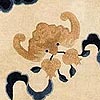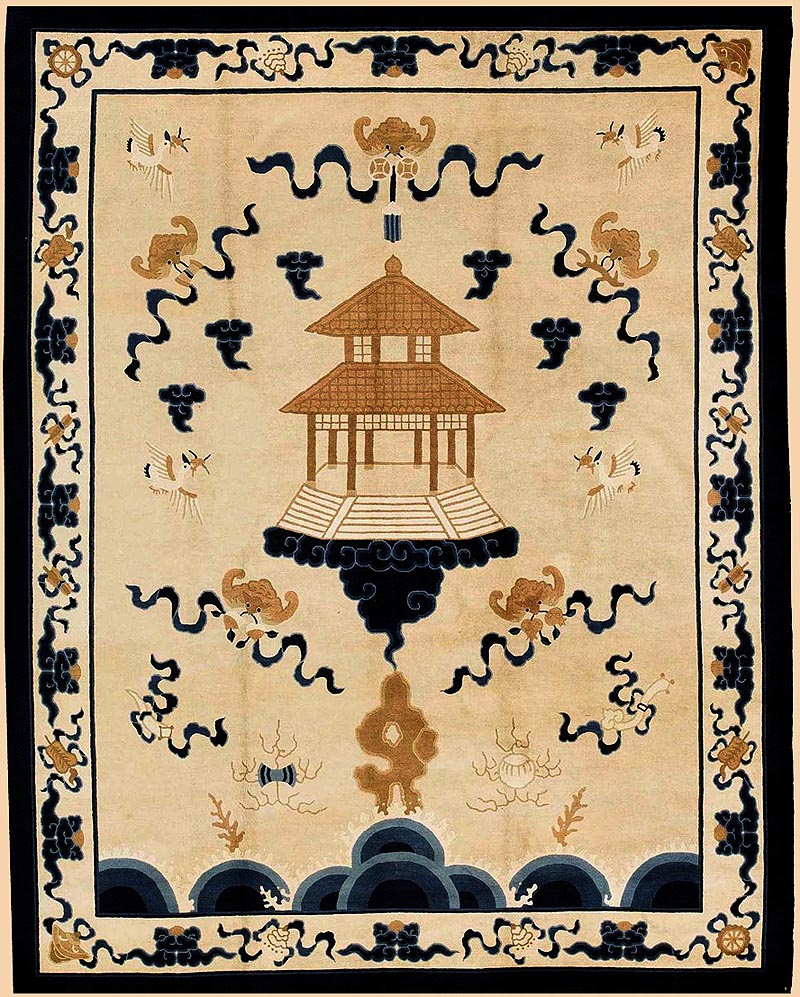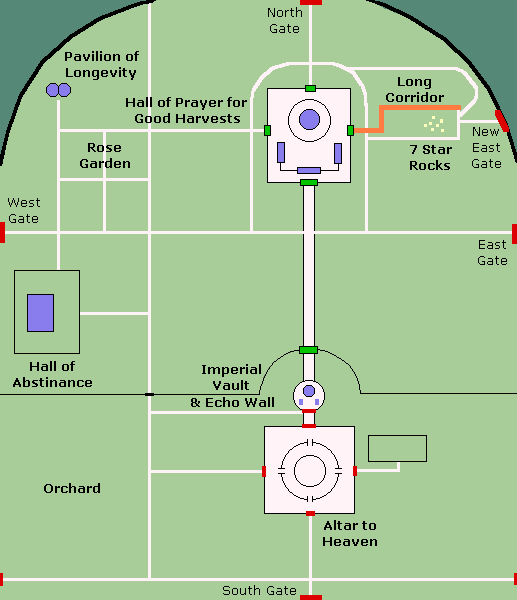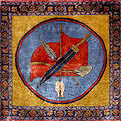 |

6334
(SOLD)
Antique Chinese Masterpieces Rug. This was made for Temple of Heaven Beijing, China
Foundation: Cotton
Pile:Wool
Circa 1895
Size:12' x 9'
|
Antique Chinese Carpet
Temple of Heaven Beijing, China
The magnificent and colorful Temple of Heaven (TianTan) was where emperors of the Ming and Qing dynasties would offer sacrifices to heaven and pray for good harvests.
The Hall of Prayer for Good Harvests.

Introduction to the Temple of Heaven
The Temple of Heaven was constructed between 1406 and 1420 during the reign of Ming Emperor YongLe (1403-1424), who also oversaw the creation of the Forbidden City during the same period.
The Temple of Heaven was originally established as the Temple of Heaven and Earth, but was given its current name during the reign of Ming Emperor JiaJing (1522-1567), who built separate complexes for the earth, sun and moon. The Temple of Earth (DiTan) can be found in north Beijing. The temples of the sun and moon are in the east and west of Beijing.
The Temple of Heaven was renovated again during the reign of Qing Emperor QianLong (1736-1795).
In 1998, the Temple of Heaven was added to the UNESCO World Heritage List.
In early 2005, the Temple of Heaven underwent a 47 million yuan (6 million USD) renovation that was completed on May 1st, 2006.
Architecture and Layout of the Temple of Heaven
The architecture and layout of the Temple of Heaven is based on elaborate symbolism and numerology.

In accordance with principles dating back to pre-Confucian times, the buildings in the Temple of Heaven are round, like Heaven (one can imagine the sky as like a rounded dome), while the foundations and axes of the complex are square (or 2 dimensional - that is, flat), like the earth (appears to be).
Thus, the buildings and their settings reflect ancient Chinese religious beliefs that imagine heaven as round and earth as square. The main buildings in the Temple of Heaven are constructed on a central north-south axis. The altar and temple are round and sit within square shaped areas.
Similarly, the northern part of the park is semicircular in shape while the southern part is square. The two parts are divided by a wall that has a semi-circular obtrusion in the middle around the Imperial Vault. This echos the shape of the park as a whole.
Similarly, the roofs of the important structures in the Temple of Heaven are tiled in blue, the color symbolizing heaven and sky (just as golden yellow symbolizes the emperor and green Buddhism).
The symbolism at the Temple of Heaven was necessary because it served as the place where the emperor, as the 'Son of Heaven', directly beseeched Heaven to provide a bountiful harvest throughout the land. This was of great importance because during the imperial period agriculture was the foundation of China's wealth.
The Temple of Heaven, with its ancient cosmological basis, in turn helped to reinforce the legitemacy of the emperor's role as head of a feudal system with a mandate from Heaven. In showing respect to Heaven through prayer and sacrifices, the emperor effectively emphasized the source of his authority.
Map of the Temple of Heaven
The Three Main Structures of the Temple of Heaven
Three principle structures lie along the primary north-south axis of the Temple of Heaven complex.
The Altar of Heaven (YuanQiuTan)
The Altar of Heaven from above.
At the southern end is the Altar of Heaven, an empty three-tiered plinth that rises 5 meters from a square yard. Constructed in 1530 and rebuilt in 1740, it is made of white marble. The altar was used to worship heaven at the winter solstice.
The Altar of Heaven.
The number of stones in the various tiers are all multiples of three and/or nine - a prevailing numerological theme at the Temple of Heaven. The number nine, being the highest value digit, symbolically represented the emperor.
On top of the Altar of Heaven. The first ring of consists of 9 stones, the 'magical' highest value digit. Then 18, 27 etc.
The Echo Wall and the Imperial Vault of Heaven (HuangQiongYu)
In the center of the north-south axis of the Temple of Heaven are the Echo Wall and the Imperial Vault of Heaven.
The Echo Wall.
The Echo Wall surrounds the Imperial Vault. It has a height of 3.7 meters and a circumference of 193 meters. It is named for its acoustical properties - a whisper spoken at one end can be heard clearly from the other. The Triple Echo Stones in the courtyard return various numbers of echos depending on which stone one stands on while facing the Imperial Vault.
The Imperial Vault of Heaven.
The Imperial Vault of Heaven sits in the center. It is a round building with a roof that resembles the Hall of Prayer for Good Harvests, though smaller and with only one gable of eaves and a single tier marble base. The back half of the building is constructed with bricks. In the past, the vault contained memorial tablets of the emperor's ancestors.
The Hall of Prayer for Good Harvests (QinianDian)
At the north end of the Temple of Heaven is the majestic Hall of Prayer for Good Harvests, an impressive three-tiered wooden structure that sits on a large, three-tiered marble plinth, 6 meters high. Although initially constructed in 1420, it burned down in 1889 and was rebuilt soon after.
The hall itself is 38 meters high (32 meters from the plinth). Remarkably, not a single nail was used in its construction - a feat that required a high level of craftmanship.
The Hall of Prayer for Good Harvests.
Inside the Hall are 28 tall pillars, each made from a single tree trunk. The four posts around the inner circle represent the four seasons. The 12 posts around the middle circle represent the 12 months. The 12 posts of the outer circle represent 12 ShiChen. In ancient China, one ShiChen equalled two hours so that a complete day was divided into 12 ShiChens.
The interior of the hall is magnificently decorated and contains a large south facing ceremonial throne.
One approaches the Hall of Prayer for Good Harvests along a 360 meter raised walkway : 'Vermillion Steps Bridge' (DanbiQiao). In doing so, one ascends almost imperceptibly, denoting progression from Earth to Heaven. The path is 1 meter high at the start and 4 meters high at the end. It is called a bridge because at one point there in a tunnel under it.
The walkway is almost 30 meters wide and has three distinct paths marked out. The central path was reserved for the gods. The path on the left was reserved for the emperor while the path on the right was used by the empress and court officials.
The walkway is flanked by centuries-old cypress trees.
Approaching the Hall of Prayer for Good Harvests.
Historical Role of the Temple of Heaven
A bi-annual procession consisting of thousands of eunuchs and ministers, plus the emperor (the Son of Heaven), would make its way from the Forbidden City to the Temple of Heaven. Ordinary citizens were not allowed to watch, or even see, the procession.
Among the gods worshiped at the Temple of Heaven originally were the god of earth, the god of water, the god of agriculture (who has his own hall - the Hall of Prayer for Good Harvests), the god of the military, the god of religion and the god of civilians.
At the Temple of Heaven, the emperor would perform sacrifices and other rituals. First, the emperor would fast in the Hall of Abstinance for several days.
Offering sacrifices was a serious task - the entire empire relied on the emperor for good fortune and abundant harvests so he had quite a responsibility. News of the ceremony was then disseminated throughout China.
Flower display near the Hall of Prayer for Good Harvests.
The Temple of Heaven Today
The Temple of Heaven has been converted into a park that is popular both with tourists and residents alike.
The park was first opened to the public in 1912 and commoners who had previously been banned from even watching the emperor's procession pass through the city to Tiantan, were now permitted to visit the Temple of Heaven themselves.
Part of the extensive and beautiful grounds.
The Temple of Heaven is a very large park, more than twice the size of the Forbidden City. As this was to be the space representing Heaven on Earth, symbolically it needed to be bigger than the Forbidden City. It is about 2 kilometers from north to south. The inner walled area that houses the main structures covers 275 Hectares (2.75 million square meters). Indeed, it is the largest group of constructions for worship in the world.
|



